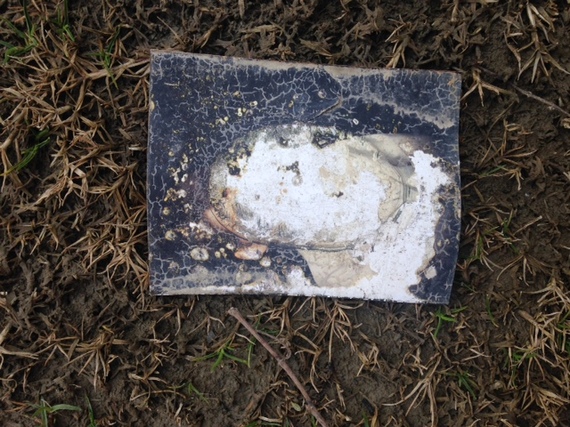New Delhi, India--When I think of Kashmir, I picture my grandmother strolling through her manicured garden in our family home in Raj Bagh. 'Cookie Mummy', as I used to call her, would be flanked on both sides by tall flowers standing at attention to salute her. The call to prayer would inescapably echo from dozens of loud speakers as my cousins and I played soccer on the soft grass.
Today, I traced my grandmother's footsteps and found cracked pictures drying out under the sun, strewn about the muddy ground where her flowers used to be. The surviving pictures have traveled with the receding floodwaters to find me here, in a muddy garden. Six months earlier, Kashmiris awoke to what they thought was the day of reckoning described in the Quran.
These are some of the crumbs left behind by nature's hunger, when her angry waters consumed the mystic and beautiful city of Srinagar this past September.
Though each photo is different, these pictures take a common trait: the faces are almost all whited-out. There are only faceless bodies and some semblances of time and place in the cracked backgrounds. Around the missing faces are spiraling yellows and browns, and muddy cracks and rips.
With these broken pictures, it is as if the flood took a self- portrait by painting over Kashmir's existing canvas of memories. In some ways, this fits into the valley's extraordinary and sometimes tragic history, where patterns of violence and enforced disappearances have also erased many lives and memories.
Whose faces are these? Three and four story houses are no more, yet these pictures remain in tact? In this moment, I fully realize how lucky I am to see my family still alive.
There is no choice but to pick up what images I can find and try and piece something together again. So is the case with the people of Kashmir today.
On a quick drive around Srinagar's Raj Bagh area, one will see masons carrying wood frames, cement and bricks. Hammers relentlessly crack against tin and metal. Mothers and sisters are clearing out debris, broken furniture and washing whatever garments they can find. Their lawns are now surgery rooms for belongings. Brick by brick, cloth by cloth, Kashmir is washing off the dirt and repairing its broken walls, torn clothes and collapsed shops.
I met many young professionals and university students who are volunteering to identify vulnerable communities. Many are carrying out citizen-led rehabilitation efforts in the absence of adequate government support for housing and water. Students, who have been more than 5 months without education programs, are eager to get back in the classroom and private tutoring lessons. And ask any rescued person; they will tell you it was the 'downtown youth' who built the makeshift boats from wood and buckets, saving countless lives.
I ask my auntie, "What were you doing for several days in your attic when three floors of your home remained under water and outside raged a brown river?" "I was praying," she replied softly. "I was praying all day and all night. I did not sleep because I was sure I was going to die, and when I was going to die, it was going to be while praying to God for forgiveness and thanks," she added.
Her husband tells me that the floods have changed his whole outlook on life. "Before, I used to be concerned with the years ahead. Now, I live for the day." This from a man who watched a family get washed away once the roof beneath them collapsed. Days later, in a refusal to let the floods claim more of his hopes, he bravely went ahead as planned and completed his son's wedding ceremony. The groom rode a boat back to the flood hit home to search for his wedding suit.
There is a unique depth to the endurance of many Kashmiris in the valley. As if nurtured by decades of violence and broken political promises by all sides, Kashmir's people endure nature's recent footprint and are trying to look forward. This is tragic on one level but remarkable on another because it does not end with acceptance. Particularly among some of its youth, there is a hunger...a hunger to unite and rebuild...a hunger to grow and not give up. Endurance is being followed up by action. And among Kashmir's women and girls, there is an unfaltering sense of duty to pick up the pieces. Many aim to sleep in their own homes by this summer.
Stability remains a luxury for many in the valley. 'Normalcy'--a term the media pre-maturely parade around when reporting on Kashmir--does not exist. There is a long road ahead and many feel once again shafted by the international community. One thing is for sure, giving up and being paralyzed is not an option. After all, would you give up on 'heaven on earth'?
I wish I were only witness to the aftermath of the floods and the remarkable resolve of Kashmiris. But I am afraid that my short time in Kashmir was rocked by a dangerous pattern of military curfews and city-wide strikes. In these fragile moments, the youth's energy can be for better, or for worse I fear. I will share more in part two of this special series from Kashmir, next week.
*You can help with present rehabilitation and relief efforts by donating to the internationally certified 'Child Nurture and Relief International' (CHINAR), based in Kashmir.

